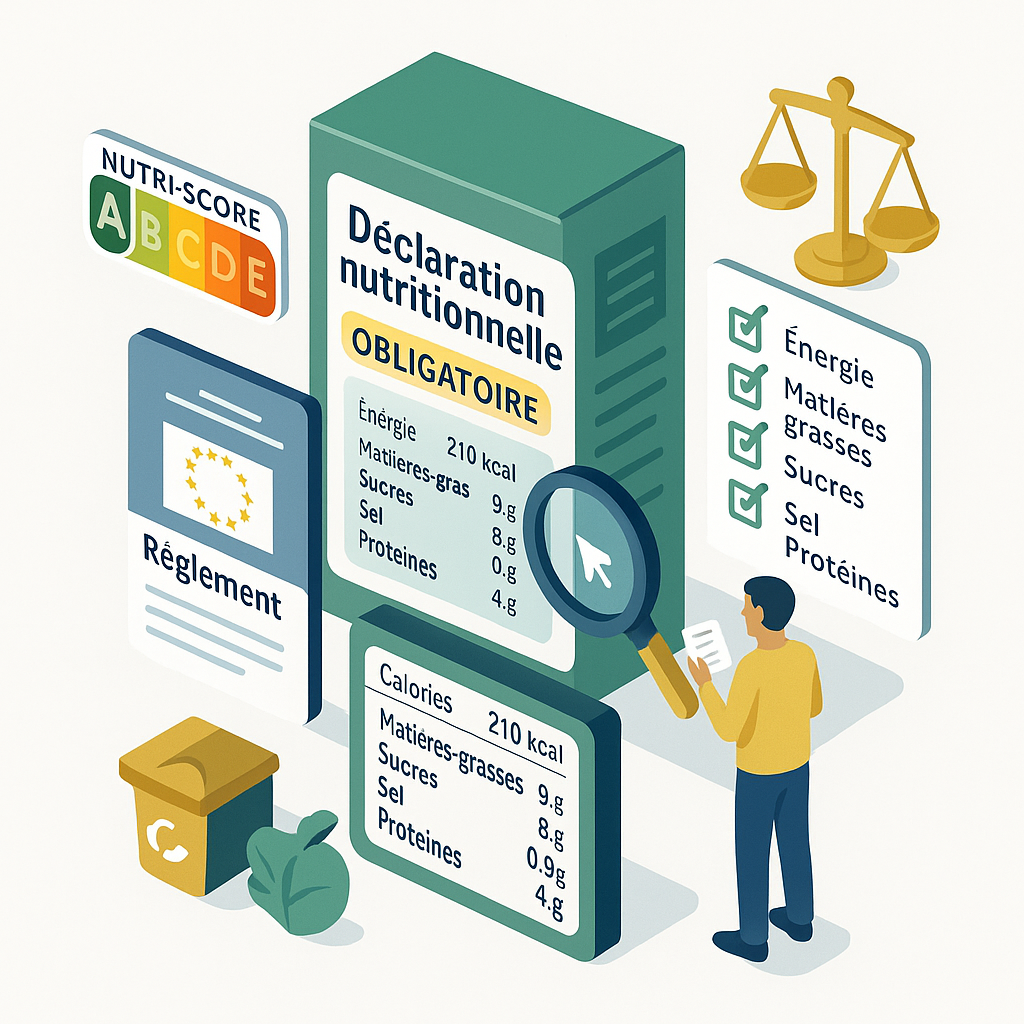Thedecree of March 14, 2025 marks a crucial step in the evolution of nutrition regulations in France. In response to the growing importance of food transparency and the need to inform consumers, this decree sets out the additional presentation requirements for the nutrition declaration, as stipulated in Articles L. 3232-8 and R. 3232-7 of the French Public Health Code.
By incorporating elements such as the Nutri-Score, this decree aims not only to improve the clarity of information provided to consumers, but also to boost confidence in foodstuffs. This nutrition labelling scheme responds to consumer concerns about health and nutrition, and underlines the authorities' commitment to promoting a balanced diet.
In this article, we take a closer look at the key provisions of this decree, the integration of the Nutri-Score into nutrition declaration practices, and the future challenges for food industry players and consumers.
If you need a consumer law attorney, contact me!
What are the main provisions of the decree concerning nutritional declarations?
The current regulations, described in the Order of March 14, 2025, are based on specific articles of the French Public Health Code, in particular Articles L. 3232-8 and R. 3232-7. These articles govern the form in which nutritional information is presented, to ensure that consumers receive clear, accessible information on foodstuffs. The decree stipulates that the form of presentation complementary to the nutrition declaration must comply with precise specifications, which are designed to make the information easier to understand. Food manufacturers and distributors must therefore adhere to these new regulations in order to obtain authorization to use the Nutri-Score, a nutritional label designed to simplify food choices for consumers.
The Nutri-Score, a nutritional evaluation method, assigns scores to food products according to their nutritional quality. The conditions for using the collective mark are strict, and are designed to comply with public health standards and the fight against diet-related diseases. This means that only foodstuffs meeting these requirements will be labelled, which is essential to ensure transparency and reliable information for consumers.
In addition to transparency obligations, the decree repeals previous regulations, including the decree of October 31, 2017 and that of August 30, 2019, ensuring uniformity in the presentation of nutritional information. This change is a step towards continuous improvement in consumer information about their food.
In short, these provisions mark a significant step forward for food regulation in France, seeking to balance the need for accurate product information with consumer health protection. This leads us to consider the integration of the Nutri-Score and its implications.
How is the Nutri-Score integrated into the presentation of nutritional information?
The integration of the Nutri-Score into the nutrition declaration is at the heart of the new regulatory requirements established by the decree of March 14, 2025. Under this decree, the Nutri-Score sign must accompany all nutrition declarations, providing consumers with a visual assessment of the nutritional quality of food products. Articles L. 3232-8 and R. 3232-7 of the French Public Health Code stipulate that the information provided must be clear, legible and easy to interpret, and the Nutri-Score plays an essential role in achieving this objective.
The Nutri-Score is a scale that assigns a score ranging from A to E, according to a product's nutritional quality. Products with an A score are considered to be the most nutritionally favorable, while those with an E score indicate lesser quality. This intuitive classification enables consumers to make informed choices quickly, by reducing the time needed to analyze often complicated detailed nutritional information.
This approach also aims to harmonize different food labeling practices, replacing existing systems often deemed confusing or inefficient. Through its application, the decree seeks to ensure that all players in the food sector adhere to the same standards when it comes to presenting information. This uniformity helps boost consumer confidence in the products they buy.
In addition, manufacturers and distributors must ensure that the use of the Nutri-Score does not conflict with other health or nutrition claims that may be present on their products. This requirement is crucial to avoid any form of misinformation, and to ensure that consumers receive reliable, non-misleading information.
Through the development and application of the Nutri-Score, the decree of March 14, 2025 strengthens the framework forconsumer information and helps set high standards for food quality. What remains to be explored are the issues and prospects linked to the application of this decree for all stakeholders in the food sector.
What are the issues and prospects for consumers and food professionals arising from the application of this decree?
The implementation of the decree of March 14, 2025 raises significant issues for consumers and food professionals alike. On the one hand, it reinforces consumers' right to clear, comprehensible information on the foodstuffs they choose. The introduction of the Nutri-Score as a nutrition labelling tool represents a step towards better nutrition education, where consumers can quickly assess the nutritional quality of products at a glance.
This decree is also part of a wider drive to promote public health. Nutritional education has become crucial in view of the rise in diseases linked to unbalanced diets. By using a standardized method of information, such as articles L. 3232-8 and R. 3232-7 of the French Public Health Code, the decree aims to change dietary behavior by encouraging healthier food choices among consumers.
For food industry professionals, the adoption of these regulations represents an operational challenge. Manufacturers and distributors have to adjust their labeling and product information practices, which may entail additional costs. They must also ensure compliance with the new requirements to avoid sanctions. However, adapting to the regulations can also provide an opportunity for continuous improvement in product quality, encouraging companies to innovate and offer healthier food alternatives.
In the long term, the decree could contribute to the creation of a more responsible food market, where the transparency and integrity of the information provided to consumers is central. By making information on nutritional quality more accessible and understandable, this decree will foster the development of responsible, conscious consumption.
The stakes involved in implementing this decree are vast, and made all the more complex by the interactions between regulations, consumer expectations and the strategies of food professionals. The framework established by the decree may evolve, requiring ongoing attention to meet future challenges in the food sector.
For further information, please consult the order on Légifrance: https: //www.legifrance.gouv.fr/jorf/id/JORFTEXT000051329233.




